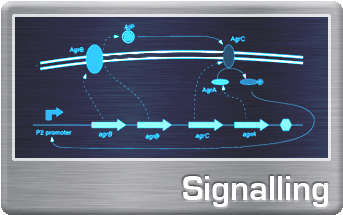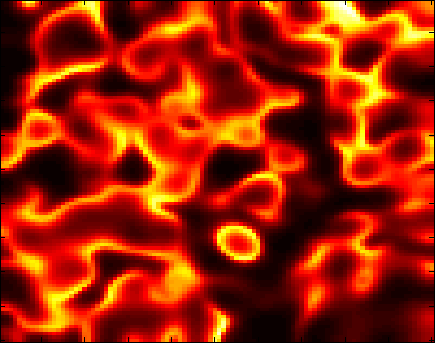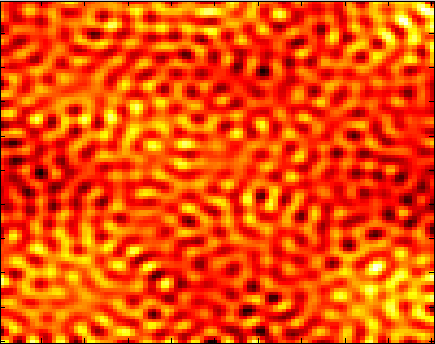|
Introduction
We are planning to implement a simple two-component Reaction-Diffusion system in the gram-positive model organism Bacillus subtilis. In 1952, Alan Turing famously described this system and suggested it as the basis for self-organization and pattern formation in biological systems. The simplest of these patterns, which we are planning to model in bacteria, mimic the spots and stripes seen on animal coats.
(A) The model consists of two diffusible signals secreted by every cell. The activator, which is controlled by a stochastic bistable switch, turns on itself and its own inhibitor. (B) A field of cells can be stably patterned into two different zones, so long as the inhibitor diffuses faster than the activator. The activator and inhibitor are synthesized in the source at the center, and turned off by accumulation of the inhibitor in the periphery.
http://parts.mit.edu/igem07/images/3/32/Cambridge_Agr_operon_and_biochemical_pathways.png
We plan to use two well-characterized bacterial communication systems to generate this behavior. The agr peptide signalling system from S. aureus will serve as our activatory signal (pictured), while the lux system from V. fischeri will serve as our inhibitor. Bacillus subtilis serves as an excellent chassis for this project because of the ease with which chromosomal integration can be performed. This project will focus on a tight integration of modeling and experiment; we will test different promoter strengths and other variables, feed these system parameters into our multi-cell models, and then use those models to tweak the regulatory machinery that will control signal production.
Grasshopper Example
The reaction-diffusion system depends on an activator and inhibitory signal that spread throughout the medium. The "grasshopper" example is quite intuitive: Imagine it is hot and there is a field of dry grass with grasshoppers. Suddenly, a fire starts burning at some point and spreads (the activator signal) so that the grasshoppers move away from that point to avoid the fire. However, the grasshoppers also generate moisture (the inhibitory signal) thus preventing the areas of dry grass the grasshoppers move to of catching fire. The initial patch will have burnt down. However, the surrounded area will be saturated by moisture generated by the grasshoppers thus preventing the fire from spreading. Imagine now that at the beginning, not a single patch, but numerous randomly distributed patches (resembling noise) of dry grass catch fire. The resulting patterning of charred grass and grasshoppers is called a Turing Pattern. It is important to note that the inhibitory signal (grasshoppers) must travel faster than the activation signal (fire) as to prevent the whole field from burning down which would result in no patterning at all.
Objective
 Schematic of Activator/Inhibitor system in B. subtilis This project seeks to generate Turing Patterns by creating a Reaction-Diffusion system in the gram-positive bacteria Bacillus subtilis. We need to integrate two signalling systems into this bacterium and use an autofeedback mechanism to generate self-organizing patterns from random noise. We plan to incorporate the agr peptide signalling system from S. aureus and the lux AHL system from V. fisheri.
Materials
Bacillus Strains
Bacillus strain 1A1 (derivative of standard strain 168)
- deficient in tryptophan, have to add to media
- keep at room temp, aren't freezable
Bacillus strain 1A771 (derivative of standard strain 168)
- deficient at tryptophan, have to add to media
- keep at room temp, aren't freezable
- contains erm insertion at amyE locus, so transformants at amyE locus can be screened for erythromycin resistance
Bacillus strain 1A751 (derivative of standard strain 168)
- deficient at tryptophan, have to add to media
- keep at room temp, aren't freezable
- knockout of Apr and Npr, two major extracellular proteases
- [http://mic.sgmjournals.org/cgi/content/abstract/141/2/281 Original Publication]
- details of vectors we are thinking of using, including maps, sequences, and testing
- list of primers we have ordered
- planning and organization of biobrick assemblies and recombinant plasmids
Mathematically, reaction-diffusion systems are coupled nonlinear differential equations that can be solved numerically. Our main goal is to create a system approximating the behaviour of the lux-activator and agr-inhibitor systems that we intend to use with B. subtilis. This will include a detailed analysis of enzyme kinematics and we hope to deduce the parameter ranges in which our B.subtilis construct will be able to form patterns, thus feeding back into our design decisions (promoter choice, rbs choice).
We will also take a significant investigative approach and ask whether Turing-like patterns can originate from systems that do not resemble reaction-diffusion. In particular, we would like to ask whether pattern formation can occur with a single signalling molecule only.
- main page detailing our day-to-day research activities
Transformation and Expression
- Checking insertion and episomal vectors
- PCRing and Ligating Bacillus Ribosomal Binding Sites
- PCRing and Ligating Bacillus Promoters
- Ligating and testing RBS + Promoter + GFP/LacZ
Lux system
Agr system
- PCRing and Ligating AGR pieces
- Assembling and testing AGR sender
- Assembling and testing AGR receiver
|
 "
"



